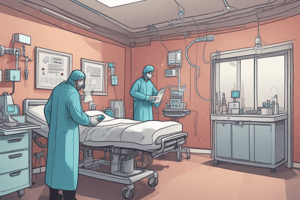Podcast
Questions and Answers
What should a firefighter do immediately after being exposed to a communicable disease?
What should a firefighter do immediately after being exposed to a communicable disease?
- Fill out a detailed report
- Consult with a medical officer
- Wait for further instructions from a superior
- Contact the on call Designated Officer through the TFS Communications Centre (correct)
What is one of the routes of entry for HIV infection?
What is one of the routes of entry for HIV infection?
- Skin contact
- Airborne transmission
- Bloodstream contact (correct)
- Fecal-oral transmission
What personal protective equipment (PPE) should a firefighter wear to prevent the transmission of Tuberculosis?
What personal protective equipment (PPE) should a firefighter wear to prevent the transmission of Tuberculosis?
- Gloves and gown
- N95 mask and gloves (correct)
- Respirator and boots
- Eye protection and bunker pants
Why is it essential to report the exposure to a Designated Officer?
Why is it essential to report the exposure to a Designated Officer?
What should a firefighter provide to the Designated Officer during the initial contact?
What should a firefighter provide to the Designated Officer during the initial contact?
What is the purpose of the Communicable Disease Protocol?
What is the purpose of the Communicable Disease Protocol?
Who should a firefighter contact in case of a communicable disease exposure?
Who should a firefighter contact in case of a communicable disease exposure?
What is the role of the Designated Officer in case of a communicable disease exposure?
What is the role of the Designated Officer in case of a communicable disease exposure?
Why should a firefighter not delay contacting the Designated Officer?
Why should a firefighter not delay contacting the Designated Officer?
What should a firefighter do after contacting the Designated Officer?
What should a firefighter do after contacting the Designated Officer?
What is the primary purpose of the guideline?
What is the primary purpose of the guideline?
Who is responsible for ensuring an appropriate response is provided to personnel affected by a communicable disease exposure or potential exposure?
Who is responsible for ensuring an appropriate response is provided to personnel affected by a communicable disease exposure or potential exposure?
What is the primary responsibility of all personnel in preventing the spread of communicable diseases?
What is the primary responsibility of all personnel in preventing the spread of communicable diseases?
What should Firefighters do when attending medical calls to prevent potential exposure to infectious and/or communicable diseases?
What should Firefighters do when attending medical calls to prevent potential exposure to infectious and/or communicable diseases?
What may be included in the proper protective equipment (PPE) worn by Firefighters when attending medical calls?
What may be included in the proper protective equipment (PPE) worn by Firefighters when attending medical calls?
What should personnel do in the event that precautions fail or other circumstances result in a potential exposure?
What should personnel do in the event that precautions fail or other circumstances result in a potential exposure?
What is the source of the guidelines for preventing the spread of communicable diseases?
What is the source of the guidelines for preventing the spread of communicable diseases?
Who is responsible for notifying the Designated Officer in a timely manner when requested?
Who is responsible for notifying the Designated Officer in a timely manner when requested?
Flashcards are hidden until you start studying
Study Notes
Purpose and Responsibility
- The purpose is to provide guidelines for preventing the spread of communicable diseases and notification process in the event of potential exposure.
- All personnel are responsible for taking necessary precautions to prevent the spread of communicable diseases.
- The Designated Officer is responsible for ensuring an appropriate response to personnel affected by a communicable disease exposure or potential exposure.
- The Communications Centre Officer is responsible for notifying the Designated Officer in a timely manner when requested.
General Guidelines
- The procedures are consistent with the Ontario Ministry of Health's Designated Officer and Infectious Disease Notification Procedure.
- Personnel should practice universal/routine precautions when providing emergency medical care.
- Universal precautions include wearing proper protective equipment (PPE) such as gloves, eye protection, N95 or surgical mask, gown, and bunker pants and boots.
Determining an Exposure
- Exposed personnel should answer questions to determine if an exposure has occurred, including:
- Was there direct contact with the medium carrying the disease?
- Was protective clothing and/or equipment worn or used?
- Was the personal protective equipment compromised?
- Is it reasonable to believe the patient/person was infected with an infectious disease?
- Was there an applicable "route of entry" for the disease?
Disease Transmission and Route of Entry
- HIV: Body fluids (blood), needle stick, broken skin, bloodstream (blood to blood contact).
- Hepatitis B, C: Body fluids (blood), saliva, bloodstream.
- Hepatitis A: Fecal/oral, contaminated fingers or foodstuffs.
- Tuberculosis: Airborne, respiratory secretions, sputum or saliva.
- Meningitis: Direct contact with discharge from nose or throat, respiratory/oral.
Exposure
- The Ontario Ministry of Health has developed a protocol for use when emergency service workers are exposed to a communicable disease.
- The protocol facilitates access to assessment, prophylaxis, and follow-up treatment for potentially exposed personnel.
- The protocol provides a contact person to inform allied agencies of possible exposure and for other agencies to call if they become aware of potential exposure.
Notification and Reporting
- Exposed personnel should immediately contact the on-call TFS Designated Officer through the TFS Communications Centre.
- Personnel should provide detailed verbal answers to a standard series of questions and submit written reports on the applicable TFS forms.
- The Designated Officer will determine if an exposure has occurred and what further treatment is required.
- DO NOT DELAY CONTACTING THE DESIGNATED OFFICER FOR ANY REASON.
Studying That Suits You
Use AI to generate personalized quizzes and flashcards to suit your learning preferences.



